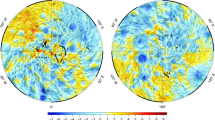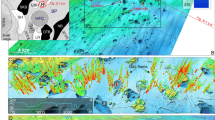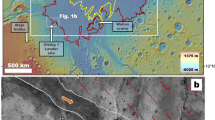Abstract
THE characteristic surface features of the inner martian satellite Phobos are impact craters and long linear depressions, here called grooves. The grooves have been explained as surface manifestations of deep-seated fractures, but there has been a divergence of opinion as to the cause of the fracturing. Soter and Harris1 have attributed the fracturing to tidal stresses induced by Mars; Pollack and Burns2 have suggested fracturing by drag forces during the hypothetical capture of the satellite by Mars; Veverka et al.3 have attributed it to a large, nearly catastrophic cratering event. We present here new data on the grooves which tend to support the cratering hypothesis and seem to rule out the tidal mechanism.
This is a preview of subscription content, access via your institution
Access options
Subscribe to this journal
Receive 51 print issues and online access
$199.00 per year
only $3.90 per issue
Buy this article
- Purchase on Springer Link
- Instant access to full article PDF
Prices may be subject to local taxes which are calculated during checkout
Similar content being viewed by others
References
Soter, S. & Harris, A. Nature 268, 421–422 (1977).
Pollack, J. B. & Burns, J. A. Bull am. astr. Soc. 9, 518–519 (1977).
Veverka, J., Thomas, P. & Duxbury, T. C. Bull am. astr. Sci. 9, 517–518 (1977).
Pollack, J. B. et al. Icarus 17, 394–407 (1972).
Duxbury, T. C. Icarus 23, 290–299 (1974).
Thomas, P., Veverka, J. & Duxbury, T. C. Bull. am. astr. Soc. 9, 517 (1977).
Hartmann, W. K. J. geophys. Res. 78, 4096–4116 (1973).
Hartmann, W. K. Icarus 31, 260–276 (1977).
Johnson, S. W., Smith, J. A., Franklin, E. G., Moraski, L. K. & Teal, D. J. J. geophys. Res. 74, 4838–4849 (1969).
Pollack, J. B. in Planetary Satellites (ed. Burns, J. A.) 319–345 (Univ. Arizona Press, 1977).
Tolson, R. H. et al. Science (in the press).
Pang, K. D., Pollack, J. B., Veverka, J., Lane, A. L. & Ajello, J. M. Science (in the press).
Pollack, J. B. et al. Science (in the press).
Chapman, C. R., Morrison, D. & Zellner, B. Icarus 25, 104–130 (1975).
Author information
Authors and Affiliations
Rights and permissions
About this article
Cite this article
THOMAS, P., VEVERKA, J. & DUXBURY, T. Origin of the grooves on Phobos. Nature 273, 282–284 (1978). https://doi.org/10.1038/273282a0
Received:
Accepted:
Issue Date:
DOI: https://doi.org/10.1038/273282a0
This article is cited by
-
Sesquinary catenae on the Martian satellite Phobos from reaccretion of escaping ejecta
Nature Communications (2016)
-
Power-law indices of asteroidal grooves and strength
Earth, Planets and Space (2001)
-
A possible origin for the grooves of Phobos
Nature (1979)
Comments
By submitting a comment you agree to abide by our Terms and Community Guidelines. If you find something abusive or that does not comply with our terms or guidelines please flag it as inappropriate.



